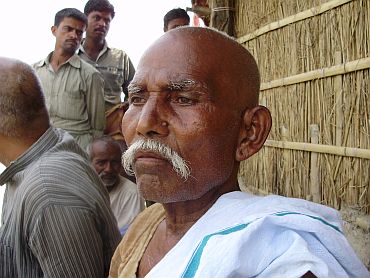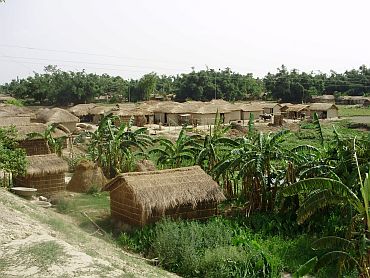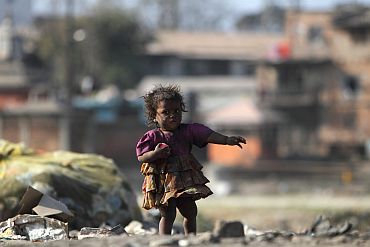 | « Back to article | Print this article |
40 years on, these villagers await rehabilitation
We went to meet the collector to ask him whether we were the citizens of this country or not. If our citizenship is terminated because of the Bagmati river project, he should issue orders to us to leave the country and get us settled in Nepal and we will go there," said Sitaram Singh, the head of Masaha Alam.
The village was in the Bairgania block of Bihar's Sitamarhi district prior to the construction of the embankments on the Bagmati in 1971-72. The village had an area of 150 acres and 420 families according to the 1971 census. Only 104 families have been accommodated and the remaining 316 families in the village are still awaiting rehabilitation 40 years ago on. They literally live on roads since the river was jacketed to prevent flooding of the plains in the river basin.
The Bagmati descends into the plains from the Shivpuri range in the Himalayas and enters India in the Sitamarhi district of north Bihar between Dheng and Bairgania railway stations on the Narkatiaganj-Sitamarhi Railway line. After passing through the districts of Sitamarhi, Sheohar, Muzaffarpur, Darbhanga, Samastipur and Khagaria and travelling a distance of nearly 400 kilometers within India, it joins the Kosi river near Badlaghat in Khagaria. Notorious for changing its course and flooding the plains, the river wreaks havoc destroying life and property in these districts every monsoon.
In order to tame the vagaries of the river, it was embanked in its lower reaches of about 145 km, from Sormarhat in Darbhanga till Badlaghat in Khagaria in the 1950s. No details are available about the number of villages or the families trapped within the embankments but the elders from the area said that immediately after Independence, everybody wanted to do his bit for the country.
Rehabilitation was, generally a non-issue, as people did not expect anything in return for the sacrifices made for society. Some people, however, were given plots outside the embankments but nobody was given a grant for building a house.
Click on NEXT to read further...
Villagers received a mere Rs 300 for relocating!
By this time the enthusiasm for doing something for the country and society had subsided as the people were disillusioned by development. They felt that they were being systematically cheated in the name of development and rehabilitation was a farce.
At least, that was the lesson from the rehabilitation of the embankment victims of the Kosi project where over 45,000 families spread over 380 villages were trapped within the embankments and their rehabilitation was far from complete.
Embankment victims of this phase of the Bagmati project were given plots of land to build their houses and a shifting allowance ranging from Rs 300 to Rs 1500 depending on the quality of the house that they had to abandon.
No grant was given to them for building their houses in the rehabilitation sites and they were supposed to cultivate their land trapped between the embankments while living at the rehabilitation sites. Even the resettlement is not given to 1,653 families scattered over 15 villages, and Masaha Alam is one among them.
According to villagers, to get the shifting allowance or a rehabilitation plot allotted to them, it was customary to pay 10 per cent of the value of the land and shifting allowance as bribe to the officers of the project. But the residents of Masaha Alam did not succumb to such pressures.
In Masaha Narottam, an adjacent village, residents made 'offerings' to the officers after teh intervention of the mukhia to ensure they got timely compensation. In June 1984, the circle officer of the Bairgania circle had written a letter to the rehabilitation officer of the Bagmati project about the pitiable condition of the residents of Masaha Alam. He requested the rehabilitation officer to help the hapless victims, but to no avail as no bribe was offered.
316 families are still rendered homeless
Construction of a ring bundh around villages trapped within the Lal Bakeya and the Bagmati was a part of this project and this area was safe from the floods. The remaining 316 families are yet to be rehabilitated.
According to the villagers, five acres of land was acquired for their rehabilitation (2.5 acres each in Bhakurhar and Nandwara) and nearly 35 families are living on these plots. Another 35 families are said to be living on their old homestead land within the village.
A few others who found it was impossible to stay in Masaha Alam, purchased land within the Bairgania Ring Bundh and earned a living by selling land or farm produce. These families live within the ring bundh under the constant threat of flooding because of a breach in the embankments of the Lal Bakeya or the Bagmati or entry of water through the sluice gates in the ring bundh.
There was a proposal to purchase land in Bhakurhar for the remaining 316 families but the landowners from that village moved the high court and got a stay order against any acquisition of land. These families are now living on the right embankment of the Bagmati, on either side of the rail line connecting Dheng to Bairgania or along a 20-feet wide strip of government land close to the right embankment of the Bagmati.
All these constructions are illegal and are liable to be vacated any time by the railways or the Bagmati project in the name of maintenance of the embankment or the police-contractor nexus. They are often chased by the police on the insinuation of engineers and contractors wanting to "carry out repairs and raise or strengthen" the embankments. Said Nagendra Rai, a villager, "A child who was 10 in 1972 is nearly 50 now. His father did not get any rehabilitation and his story is no different."
In 2009, villagers decided to fight their own battle
But the brokers only milked the villages and did nothing as promised. When the villagers realised that they were being taken for a ride by these unscrupulous elements, they blocked their entry into the villages.
The villagers have decided to fight their own battle spearheaded by Sitaram Singh. He has been running from pillar to post hoping to find a solution to the rehabilitation issue.
He said, "In 2009, officials had to evacuate the embankments where many of us live. Winter was at its peak and we requested the officials if they provided us with some polythene sheets we will vacate the embankment. But the police inspector insisted that we should leave within 24 hours. We asked for three days, but they paid no heed."
This is when the villagers decided to fight back. Up in arms against the corrupt officials, they sat on a dharna on the rail line connecting Dheng to Bairgania, the only connect to other parts of the stare.
"The rail services were hit because of our protest and our fight gained momentum. The contractors and the police returned to evacuate the village and we confronted them with all our might. It led to a fistfight and the police resorted to firing in 'self-defence'," said Sitaram Singh.
The matter was then dragged to court. "We took a stand and told the government that we will vacate the land if we are rehabilitated. Follwing this, the collector called the station house officer telling him not to harass us and vandalise our village. He told us not to leave the embankment, but asked us not to block the movement of traffic," he added.
Now, the government cannot find land for rehabilitation
Around 10-12 years ago, the collector of Sitamarhi called a meeting of the local block development officer, circle officer, rehabilitation officer, mukhias of Nandawara, Musa Chak and Masaha Alam to tell the villagers that they should accept land in patches in Musa Chak, Nandwara, Bel and Dumar Banna, but the villagers were not prepared to accept this proposal.
The government told the villagers that it was tired of acquiring land and was not in a position to do anything anymore. "Despite all the powers vested in you, if the government was not in a position to do anything, what should we do when they don't have any authority," the villagers asked.
The third phase of the project was started in 2006 to complete the embankments between Runni Saidpur and Sormar Hat. And before the same complaints start flying around, shouldn't those left homeless by the second phase get their due? Will the Nitish Kumar government that returned to power with a thumping majority in November last year in Bihar take care of the backlog?



